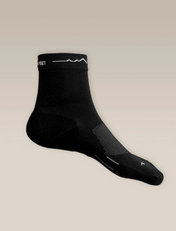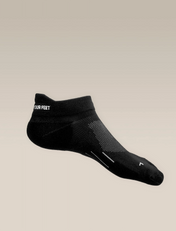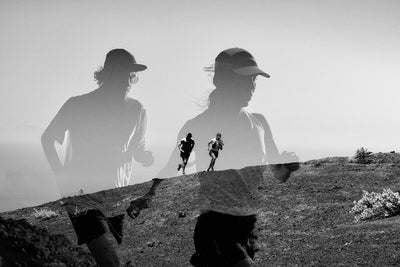
Is running really as simple as we make it out to be. Of course the motion of pulling on your shoes and stepping out a door anywhere makes it appear simple. Once out the door we take one step forward, push strongly, move our other leg forward... and away we go. As we warm up we begin to exert a little more effort and our speed gets faster and faster. Simple! But is it really the case? Research shows that the answer is a loud NO.
As I open my eyes more and more to the world of running I am continually amazed by how complicated the sport is. The actual act of running and how each individual sequence of limb movements come together to carry us smoothly forwards is more attuned to ballet dancing than it is to anything else. Where we place our feet, the landing point, the subtle shifting of our weight and the counterbalances we put in place are all unconscious things that keep us in a state of running harmony. Further to this, the ground isn’t always flat nor the surface we are running on smooth. And what happens if you need to accelerate or decelerate? Go uphill or downhill? Or even crash through the bush with a map in our hand? Imagine that!
In this article I will explore the science behind running propulsion and discuss some amazing research recently released on flat, uphill and downhill running. During the article I will also try to highlight some important running technique tips that might help to make you faster and more efficient.
To run across flat terrain we need to utilize energy to move us forward. There are two types of energy at our disposal: the energy that we hold within our bodies, stored as glycogen or fat (protein can be used but is the least preferred source of fuel); or gravity, our free energy source. When we run on flat surfaces, the energy that we need to put in is directly proportional to the amount of forces opposing us.
Propulsive Force = Braking Force
The greatest opposing force that we have is the breaking forces we generate when our foot hits the ground. There are other opposing forces such as wind resistance and how much lateral movement we get from our running style, but where are foot strikes makes a considerable difference.
Studies have shown that if our foot lands directly under our center of mass, then we have a lower breaking force than if it lands out in front of us. Further to this, if our torso is gently pressing forward and giving us the appearance of a lean then we are more likely to have our feet landing under our center of gravity. In this position we are also tapping into the energy of gravity that will help us to move forward, thus reducing the amount of energy we have to put in.
Interestingly, the metabolic energy we have to put into running on the flat falls into three different categories:
• 2/3rd of the energy we expend is to maintain vertical force to support our body weight
• 1/3 energy is expended in propulsion to move us forward
Therefore, to run fast on the flat we want to:
• Shift our body posture forward so that we can utilize the energy of gravity.
• Ensure our feet are striking directly under our center of mass.
• Reduce any other opposing forces like excessive lateral movements of the arms, loose clothing or head tilting too far backwards.
• Ensure that we are not carrying too much excess weight (this is why running with water or a pack can also use up a lot more energy)
• And lastly, ensure that our muscle and liver glycogen stores are fully topped up because no matter how hard we try we still have to put in some energy.
Sadly, the ground isn’t always flat and on almost every run you will encounter a hill. So what happens now?
When we run uphill it becomes much harder to get our feet under our body. We also tend to want to slouch which makes us feel heavy. Despite this and contrary to what we might think, our braking forces actually reduce by approximately 40%. This is due to the fact that our foot strikes the ground with less force than when we run on the flat. In fact, by the time we are running on a nine percent gradient, the impact forces are almost negligible. However, the reason hill running is so tough is that the parallel propulsion we have to apply has to increase so dramatically to overcome gravity. For example, on a nine percent gradient, parallel forces have to increase by almost 75%. That is a lot of energy!
Therefore, to run faster up hill we need to:
• Remain tall and slightly leaning forward to capture some energy from gravity
• Increase our leg speed and shorten our stride length to decrease the amount of vertical we climb with each step.
• Increase our leg stiffness so that when our foot hits the ground we get a greater return on our energy. To envisage this, picture a kangaroo when it lands and how effortlessly it spring back off the ground – I will discuss in later articles how to achieve increased leg stiffness.
We are always grateful when we get to the top of a hill and begin the descent. However, often by the time we are half way down the hill our quads are burning and our knees complaining. Sometimes we can even be surprised by how much energy we feel like we are using up.
When we run downhill our braking forces are dramatically greater than our propulsive forces.
Braking Force > Propulsive Force
In fact, by the time we hurtle down a nine percent gradient, our braking forces have increased by a whopping 108%! Therefore, even though we have gravity and momentum in our favour, our bodies still have to absorb a huge amount of shock from the impact of downhill running and at the same time apply some energy to overcome these forces.
Further to this, in downhill running our muscles are eccentrically contracting to brake us (ie. while under tension the muscles are lengthening) and yet we still have to provide some concentric contraction to create propulsion (ie. the muscles shorten whilst generating a force). This strange mix of muscle contractions to overcome the huge braking forces guarantees that downhill running is actually quite energy intensive. Research also shows that landing on stiff legs when running down hill also causes the braking forces to increase further.
Therefore, to run fast downhill we need to:
• Remain tall and even slightly tilting forward. This helps to ensure that your feet do not land too far out in front of you, creating large braking forces.
• Gently soften your knees so that your legs are not so stiff and don’t jar with every step.
• Strengthen your muscles and practice eccentric loading during strength workouts.
• Where possible decrease the amount of excessive weight you are carrying.
As you can see, behind every step that we take when we hit the trails or brave the bush lands is an intricate series of energy ‘ins & outs’. The alterations in surfaces and slopes change the way our muscles need to respond. Sometimes they will be contracting strongly to propel us forward and other times they will be eccentrically contracting to slow us down. Sometimes gravity will be working in our favour, and sometimes completely against us. Therefore, it is important to begin thinking about the way you catch, create and utilize the energy that you have available to you. When you are orienteering, this might be the difference between having enough energy to think clearly to the end of the race, and running out during those last few critical controls.



